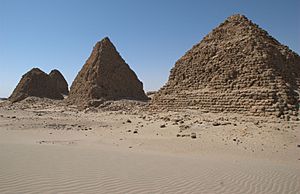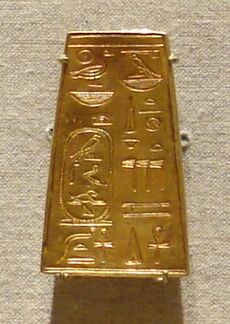Napata facts for kids
Napata was an important ancient city in the Kingdom of Kush. It was located near the fourth waterfall of the Nile River. Today, you can find its ruins near the modern town of Karima, Sudan.
Napata was a very special place for the ancient Egyptians. They believed it was where their god Amun lived. It was the southernmost permanent settlement in the New Kingdom of Egypt. Later, Napata became the capital city of the Twenty-fifth Dynasty of Egypt. After this dynasty fell, it remained the capital of the Kingdom of Kush.
Even when the capital moved to Meroë in 593 BC, Napata stayed important. It was still the main religious center for the Kushite kingdom. The city was attacked by the Romans in 23 BC, but it was rebuilt. It continued to be a key place for the worship of the god Amun.
The name "Napata" can also refer to the time period when the Kushite kingdom was strong. This was from about 750 BC until 270 BC. After this, Meroë became the main place for royal burials. The time after 270 BC is called the Meroitic period.
Contents
Napata's Beginnings
Napata was founded by Thutmose III in the 1400s BC. This was after he conquered the land of Kush. Egyptians thought the Nile River's yearly floods were like creation itself. So, Napata, being the farthest south in their empire, became a very important religious place.
A tall sandstone hill called Jebel Barkal became a special spot. Egyptians believed their main god, Amun of Karnak, lived there. A religious center, also called Karnak, was built near Jebel Barkal. The town that grew around it became known as Napata.
Around 1075 BC, the priests of Amun in Thebes (Egypt's capital) became very powerful. They started to limit the power of the pharaohs. This led to a time called the Third Intermediate Period of Egypt. During this time, the Kushites gained their freedom. They became more separate from the Egyptian priests.
The Kushites then formed their own kingdom, with Napata as its center. An ancient stone tablet from the 700s BC shows a Kushite king. It says he was the only true ruler chosen by the god Amun. This king appointed other smaller rulers in Egypt.
The Napatan Kingdom
By 750 BC, Napata was a well-developed city. Egypt, however, was still having political problems. A Kushite king named Kashta took advantage of this. He attacked Upper Egypt. His successors, Piye and Shabaka, continued his plan.
Shabaka eventually took control of the entire Nile Valley. This happened in the second year of his rule. Overall, Kushite kings ruled Upper Egypt for about 100 years. They ruled all of Egypt for about 57 years, from 721 to 664 BC. These kings are known as the Twenty-fifth Dynasty of Egypt.
The Amun priests in Thebes supported these Kushite kings. The kings believed their power came from Amun of Jebel Barkal and Amun of Karnak. In their art, they wore a special skull-cap crown. This crown looked like Jebel Barkal. It showed that their power came from that "Pure Mountain."
The 25th Dynasty brought Egypt back together. The empire became as large as it was during the New Kingdom. This time was like a rebirth for Egypt. Art, religion, and building styles went back to older, grander forms. Pharaohs like Taharqa built or fixed temples and monuments. This happened in places like Memphis, Karnak, Kawa, and Jebel Barkal.
Battles with Assyria
The reigns of Pharaoh Taharqa and his cousin Tantamani were full of fighting. They constantly battled the Neo-Assyrian Empire. Around 670 BC, the Assyrian emperor Esarhaddon conquered Lower Egypt. He let local rulers stay there. This was to make them his allies against the Kushite rulers.
When Ashurbanipal became the new Assyrian king, Taharqa tried to get some Egyptian rulers to break away from Assyria. But Ashurbanipal defeated this group. He appointed Necho I as ruler of Memphis and Saïs. Necho I became the first king of the Twenty-sixth Dynasty of Egypt.
In 664 BC, the Assyrians delivered a final blow. They attacked and looted Thebes and Memphis. Taharqa died in the same year. The new Kushite king, Tantamani, killed Necho I when he tried to invade Lower Egypt. However, Tantamani could not defeat the Assyrians. They supported Necho's son, Psamtik I.
Tantamani eventually gave up trying to conquer Lower Egypt. He went back to Napata. But he still had power over Upper Egypt until 656 BC. That's when Psamtik I sent his navy to Upper Egypt. He succeeded in taking control of all of Egypt.
The 25th Dynasty ended with its rulers returning to Napata. All the pharaohs of this dynasty were buried there. Their tombs were under the first pyramids built in the Nile valley since the Middle Kingdom. These pyramids were at El-Kurru and Nuri. The Napatan dynasty continued to rule the Kushite state. It thrived in Napata and Meroë for many more centuries.
Later Napata
Napata remained the center of the Kingdom of Kush for about 60 more years. This was from the 650s to 590 BC. Its economy mainly relied on gold. Egypt's 26th Dynasty was an important trading partner.
The buildings, paintings, and writing of Napata were in the Kushite style. They also followed Egyptian burial customs, including building pyramids. Many ancient Egyptian gods were worshipped. The most important god was Amun. The Temple of Amun and the Temple of Mut were the most important temples in Napata. They were located at the foot of Jebel Barkal.
After the Persian Empire conquered Egypt, Napata lost its economic power. The Napata region also became drier. This meant less cattle and farming. A Persian attack in 591 BC also badly affected Napata.
Finally, Napata lost its role as the main economic city to Meroë. The area around Meroë was rich in iron. Iron was becoming a very important resource. So, Meroë eventually became the new capital of the Kingdom of Kush. This led to Napata being less important.
In 23 BC, the Roman governor of Egypt, Gaius Petronius, invaded Kush. He had 10,000 soldiers. This happened after the queen of Meroë attacked first. Petronius destroyed Napata. The Roman emperor Augustus later wrote that his army reached "the town of Napata."
After the Roman attack, King Natakamani rebuilt Napata. He fixed the temple of Amun and built a palace. Later, the site was left empty. Its buildings were robbed and destroyed. It is thought that changes in religion might have caused this.
Archaeological Finds
American archaeologist George A. Reisner found ten statues at Napata. These statues were of kings like Taharqa, Tanwetamani, Senkamanisken, Anlamani, and Aspelta. This discovery was partly by chance. Reisner found the first group of statues while looking for a place to dump dirt. Weeks later, he found more pieces in the nearby Amun temple.
Ash was also found with the statue pieces. This made Reisner think the statues were destroyed on purpose. Since they were found close by, it is believed the statues were once displayed in the Amun temple.
The oldest known building at Jebel Barkal is the Enthronement Pavilion. It dates back to the time of Thutmose IV. This building is next to the Jebel Barkal cliff. Rocks falling from the cliff damaged the building several times. This happened in the 200s BC and the 1st century AD. We are not sure what this building was used for in the 18th Dynasty. But we know it was used for royal coronations in the 200s BC.






